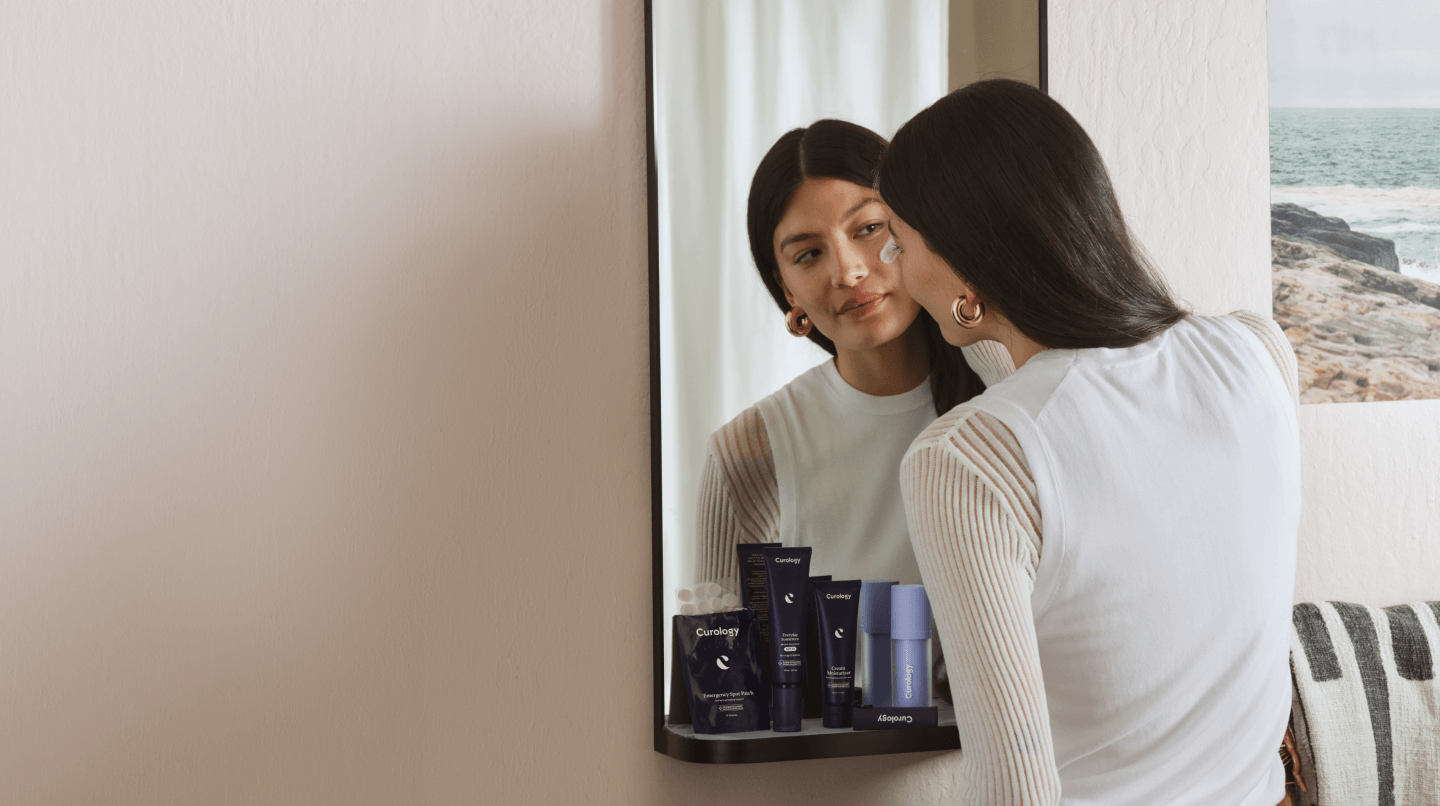How it works:
Share your skin goals and snap selfies
Your dermatology provider prescribes your formula
Apply nightly for happy, healthy skin
How it works:
How it works:
Share your skin goals and snap selfies
Your dermatology provider prescribes your formula
Apply nightly for happy, healthy skin
How it works:
Everything we know about baby Botox
The deal with using Botox as an anti-aging preventative treatment.



Here at Curology, we currently focus on diagnosing and treating skin conditions like acne, rosacea, signs of aging, and hyperpigmentation. We do not treat many of the conditions mentioned in this article. This article is for information purposes only.
If you’re concerned about signs of aging but aren’t quite ready for the full-on effects of traditional Botox, “baby Botox” may be an option worth considering.
This skincare treatment has nothing to do with babies. Rather, it refers to injecting fewer units of Botox into the face, resulting in a more subtle, natural-looking result. Here we’ll delve into the world of baby Botox, including how it works, how it’s different from traditional treatment, and its potential benefits and side effects. Curious about how long it typically lasts? We’ll cover that, too. If you’re considering this treatment, here’s the 411 on what it may be able to do for your skin.
What is baby Botox?
It's important to note that baby Botox is not an official medical term, but essentially, it refers to using fewer units of Botox than may be typically injected—a micro dosage, so to speak. The goal is to help prevent and smooth out fine lines and wrinkles without causing that frozen or “plastic” appearance for which Botox is so stereotypically known. It’s a popular option among those who want to address the signs of aging while maintaining a natural look, especially for people who are younger.
Like traditional Botox, baby Botox is administered through a series of injections and works by relaxing the muscles that can lead to wrinkles with repetitive movements.¹ It’s a quick and relatively painless procedure that can help you achieve a more youthful and refreshed appearance.
How does Botox affect the skin?
Botox (botulinum toxin) is a potent neurotoxin produced from the bacteria Clostridium botulinum.² It’s a popular treatment that works by temporarily relaxing the muscles in the injected area, helping smooth out fine lines and wrinkles and helping to prevent new ones from forming. It’s often used by dermatology providers to target the muscles involved in facial expressions like frowning, squinting, and raising the eyebrows, which can help to diminish the appearance of the signs of aging, like crow’s feet and frown lines. Typically, a dermatology provider can administer a Botox treatment during a single office visit.³
In addition to the cosmetic benefits of Botox, it’s also FDA-approved to treat a medical condition called hyperhidrosis, or excessive sweating, when other treatments applied to the skin are ineffective.⁴ Additional therapeutic uses of Botox injections include chronic migraines, certain eye or facial spasm disorders, and cervical dystonia.⁵
Baby Botox vs. traditional Botox
When comparing baby Botox treatment to traditional Botox, the main difference lies in the amount of Botox injected into the skin. Baby Botox simply refers to using smaller doses of the neurotoxin, typically fewer units, in the desired treatment area. On the other hand, traditional Botox usually involves injecting a larger number of units. Baby Botox is often used as a preventative measure to help prevent the appearance of fine lines and wrinkles. In contrast, traditional Botox is used for preventative and corrective purposes, addressing more severe wrinkles and lines on the face.⁶
Both techniques use the same substance and work by relaxing the facial muscles that cause wrinkles; the primary difference is the amount of Botox used. Both baby and traditional Botox are administered through a series of injections. How many units is baby Botox? There’s no firm answer to this, as the number of units you receive during this cosmetic procedure must be discussed with your dermatology provider.
Potential side effects of baby Botox
While baby Botox and traditional Botox are typically considered safe and effective treatments, there are a few potential side effects to be aware of. That said, Botox used for cosmetic purposes is considered not to pose severe risks in most cases,⁷ but they may include:
Bruising around the injected areas: You may experience injection site reactions, such as bruising around the treatment areas.⁸
Asymmetrical results: In some cases, the effects of baby Botox may be asymmetrical, meaning that one side of your face may look different than the other. This can often be corrected with a touch-up treatment.⁹
An undesired facial appearance: With baby Botox, there’s a small risk of experiencing undesired issues like drooping eyelids (aka ptosis).¹⁰
Other side effects: In some cases, baby Botox may cause other adverse effects like headaches, allergic reactions, and flu-like symptoms.¹¹
How long does baby Botox last?
This is one of the most common questions about Botox! Here’s the scoop: Typically, the effects of baby Botox will last from three to six months. After that, your muscle action will gradually return, although this can vary from person to person based on factors like your age and the amount of Botox injected. Immediately following treatment, it typically takes one to four days to see effects, with maximum effects of baby Botox seen after one to four weeks.¹²
Curology is here to help
If you’re considering making changes to your anti-aging skincare routine, our experts recommend consulting a dermatology provider. Medically backed treatment can help alleviate specific concerns, including signs of aging, acne, and rosacea. While we don’t offer Botox, we do offer topical anti-aging ingredients like tretinoin, azelaic acid, and tranexamic acid.

Founded in 2014 by a board-certified dermatologist, Dr. David Lortscher, MD, Curology strives to offer accessible and effective skincare. We’re a skincare service offering products made with proven-effective ingredients, including those that treat fine lines, wrinkles, and hyperpigmentation. Our products are dermatologist-designed, vegan, and cruelty-free.
Curology helps take the guesswork out of your skincare routine—our licensed dermatology providers work with you to examine your skin, assess your skincare goals, and create a custom treatment plan for you, complete with a personalized prescription formula to address your skin concerns.
Signing up is quick and easy. Just answer a few questions and snap some selfies to help us get to know your skin better. If Curology is right for you, we’ll pair you with one of our in-house licensed dermatology providers. They’ll guide you on your skincare journey and answer any questions you may have.
FAQs
It's important to note that baby Botox is not an official medical term, but essentially, it refers to using fewer units of Botox than may be typically injected—a micro dosage, so to speak. The goal is to help prevent and smooth out fine lines and wrinkles without causing that frozen or “plastic” appearance for which Botox is so stereotypically known. It’s a popular option among those who want to address the signs of aging while maintaining a natural look, especially for people who are younger.
Botox (botulinum toxin) is a potent neurotoxin produced from the bacteria Clostridium botulinum. It’s a popular treatment that works by temporarily relaxing the muscles in the injected area, helping smooth out fine lines and wrinkles and helping to prevent new ones from forming.
This is one of the most common questions about Botox! Here’s the scoop: Typically, the effects of baby Botox will last from three to six months. After that, your muscle action will gradually return, although this can vary from person to person based on factors like your age and the amount of Botox injected.
P.S. We did the homework so you don’t have to:
Padda, I.S., Tadi, P. Botulinum Toxin. StatPearls. (2022).
Padda, I.S., Tadi, P. Botulinum Toxin. StatPearls. Ibid.
Botulinum toxin therapy: Overview. Journal of the American Academy of Dermatology. n.d.
Botulinum toxin therapy: Overview. Journal of the American Academy of Dermatology. Ibid.
Padda, I.S., Tadi, P. Botulinum Toxin. StatPearls. Ibid.
Humphrey, Shannon, et al. Preventive, Cumulative Effects of Botulinum Toxin Type A in Facial Aesthetics. Dermatologic Surgery. (December 2017).
Witmanowski, H., Błochowiak, K. The whole truth about botulinum toxin - a review. Postepy Dermatol Alergol. (2020).
Mohan, A., et al. Botulinum toxin type A injections: Adverse events reported to the US Food and Drug Administration in therapeutic and cosmetic cases. Journal of the American Academy of Dermatology. (Ibid).
Mohan, A., et al. Botulinum toxin type A injections: Adverse events reported to the US Food and Drug Administration in therapeutic and cosmetic cases. Journal of the American Academy of Dermatology. (Ibid).
Mohan, A., et al. Botulinum toxin type A injections: Adverse events reported to the US Food and Drug Administration in therapeutic and cosmetic cases. Journal of the American Academy of Dermatology. (Ibid).
Mohan, A., et al. Botulinum toxin type A injections: Adverse events reported to the US Food and Drug Administration in therapeutic and cosmetic cases. Journal of the American Academy of Dermatology. (Ibid).
Satriyasa, B.K. Botulinum toxin (Botox) A for reducing the appearance of facial wrinkles: a literature review of clinical use and pharmacological aspect. Clin Cosmet Investig Dermatol. (2019).
Donna McIntyre is a board-certified nurse practitioner at Curology. She obtained her Master of Science in Nursing at MGH Institute of Health Professions in Boston, MA.
* Subject to consultation. Subscription is required. Results may vary.

Curology Team

Donna McIntyre, NP-BC
Related Articles
How to use acne body wash correctly: Your straightforward guideMen skin care: top concernsHow to get rid of body and back acne?Face sunscreen for sensitive skinSunscreen for eyes: How to protect your delicate skin from UV raysPopular Articles
Ask Curology: Is my cold breaking me out?Slugging: The dermatologist-approved skincare hack going viral on TikTokTretinoin vs retinol: What’s the difference?How to create a self-care routine that actually sticksYour 2023 skincare horoscopeTry prescription skincare
Get routine essentials


Face what’s next with Future-ProofRx
Face what’s next with Future-ProofRx
- Skin texture
- Fine lines
- Wrinkles
- Dark spots
- Dullness
$29.95/month